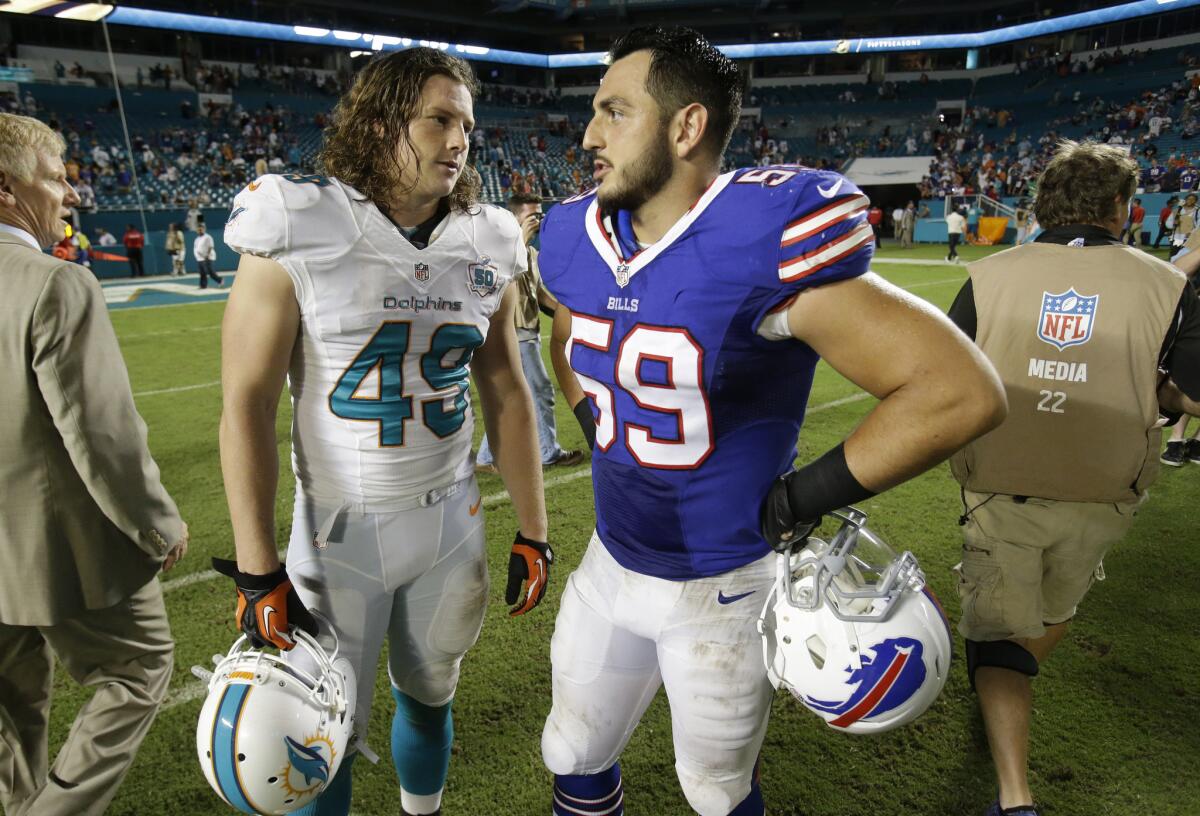Opinion: Another NFL draft, another crop of young brains to irreparably damage

Buffalo Bills linebacker A.J. Tarpley (59) talks with Miami Dolphins linebacker Zach Vigil at the end of an NFL game last season, Tarpley’s first year in the league. Citing fears over long-term brain damage from concussions, he recently retired.
Imagine there was an occupation that was physically intense, and whose practitioners were exposed on a regular basis to working conditions that could lead to debilitating and progressive brain disease. Big labor would be all over it. There would be demands for an investigation by the federal Occupational Safety and Heath Administration. Consumer boycotts would direct a spotlight.
But when the job is being a professional football player, little of that has happened.
On Thursday, the National Football League holds its annual draft of college players hoping to break into the professional level. Let’s hope the players are open-eyed about what they will be getting themselves into, rather than blinded by the big contracts ahead of them.
A study unveiled earlier this month by the American Academy of Neurology found that more than 40% of retired professional football players suffer from some level of brain injury. That conclusion was drawn from the results of MRI scans of live former players, and helps broaden our understanding of just how pervasive such injuries are in professional football.
It followed an earlier report by Boston University in which autopsies revealed chronic traumatic encephalopathy, progressive deterioration caused by repeated brain trauma, in 90 of 94 brains of former NFL players. The results, while staggering, could be skewed because many of the brains were likely donated because of concerns that the dead player may have suffered from the illness. But the MRI-based study of live players bolsters those results while helping better frame the extent of the problem.
When I started playing football as a little kid, the last thing on my mind was, ‘Will I be able to walk when I’m 50? Will I be able to keep a train of thought when I’m 45?’
— Thurman Thomas, Hall of Fame running back for the Buffalo Bills
And it’s significant. Even the NFL, which had long rebuffed allegations that its business model was imperiling the health of its workers — the players — acknowledged the problem last month when Jeff Miller, the league’s vice president for health and safety, told a congressional committee that football and CTE are linked. And it extends far below the level of professional players. The Boston University study also found unusually high numbers of people who played tackle football in high school and college suffered from CTE. In fact, the risk of concussion may be higher among younger athletes because of the immaturity of the brain itself.
Such revelations already are having an effect. The NFL has changed some rules on tackling (and needs to change more) to try to reduce exposure to hard hits to the head. Will that have an effect on a sport built upon violence? Who knows.
Still, fear of developing progressive brain damage or other debilitating injuries has led several young players to walk away from potentially lucrative careers. Just over a year ago, linebacker Chris Borland retired after his first NFL season with the San Francisco 49ers after suffering a concussion in a preseason game that led him to research just exactly what he was exposing himself to. “From what I’ve researched and what I’ve experienced, I don’t think it’s worth the risk,” he told ESPN. “I’m concerned that if you wait till you have symptoms, it’s too late.”
Former Stanford linebacker A.J. Tarpley announced his retirement earlier this month after playing one season with the Buffalo Bills, and suffering the third and fourth concussions of his football career. “This decision is the hardest I’ve made yet,” Tarpley explained in his announcement on Instagram, “but after much research and contemplation, I believe it’s what is best for me going forward.”
Thurman Thomas, a former Buffalo Bills running back now in the Hall of Fame, noted last week in his first public discussion of his experience with concussions, that he never contemplated the future aggregate effects of injuries he would endure, according to the Niagara Falls Review coverage of his speech.
“When I started playing football as a little kid, the last thing on my mind was, ‘Will I be able to walk when I’m 50? Will I be able to keep a train of thought when I’m 45? When I’m 50, will I suffer from uncontrollable mood swings? And even worse, will someday I be so depressed that I would take my own life?’” he said.
“You go out on the field like any other kid, and you just start knocking the hell out of each other, trying to get the football, trying to be the hero, trying to score the winning touchdown, or trying to score the winning field goal.
“Back when I played, you might have got a headache, or you didn’t quite know where you were, but you took a couple Tylenol, a couple Advil, [and] you got right back out there because you just didn’t know.”
Repeated hits to the head, and several concussions, have left him with uncontrollable mood swings and occasional lapses of memory or awareness, he said. He spoke of “the most difficult call I’ve ever made,” when he didn’t know where he was a few years ago while driving a route he takes nearly every day. He had to pull off the road and call his wife
Despite that, Thomas lets his 14-year-old son — who has already suffered concussions — play football.
What is the solution? Frankly, I don’t know. I’ve watched football for as long as I can remember, and having grown up in Western New York I still follow the Buffalo Bills. I wrote last year about my growing indifference to watching games, and it’s becoming difficult to not be repelled by the dark side of professional football — its atrocious historical indifference to domestic violence, its foot-dragging on concussions, its failure to compel the Washington Redskins to drop it racist name.
The core of the business is entertainment, and we flock to fields, plop down in front of televisions, buy team jerseys and other paraphernalia, and manage our own teams through (very lucrative) fantasy football leagues. When the St. Louis Rams decided to return to Los Angeles for the upcoming season, football fans rejoiced (fittingly, the team will play the first season in the Coliseum).
It’s our cash and viewing habits that support this enterprise that exposes the players to exceedingly dangerous working conditions. So why do we accept in this industry what we wouldn’t in others?
Follow Scott Martelle on Twitter @smartelle.
More to Read
A cure for the common opinion
Get thought-provoking perspectives with our weekly newsletter.
You may occasionally receive promotional content from the Los Angeles Times.











